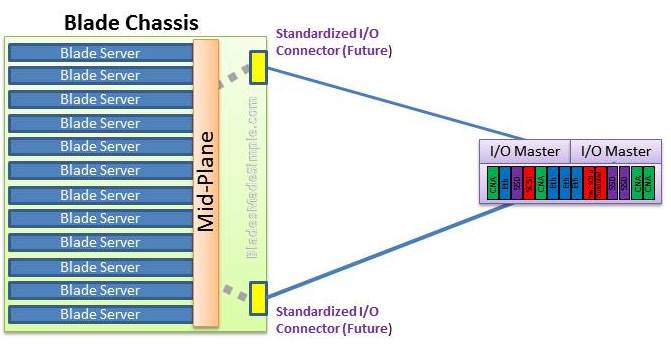- A server architecture that houses multiple server modules ("blades") in a single chassis.
Either self-standing or rack mounted, the chassis provides the power supply, and each blade has its own CPU, memory and hard disk
Diskless Blades
With enterprise-class blade servers, disk storage is external, and the blades are diskless.
This approach allows for more efficient failover because applications are not tied to specific hardware and a particular instance of the operating system.
The blades are anonymous and interchangeable
http://www.answers.com/topic/blade-server
- The Next Evolution of the Blade Server – External I/O Expansion
- Blade System Series Part-1
BackPlane :- This component is assembled inside the chassis to provide high speed IO (input/output) path to Blade Server via I/O Bays.
Bays :- Consider this as a slot where you can install blades. Bays can be customized to allow full/Half height blades installation or Mixture of both.
I/O Interconnect Bays :- These are again empty slots where you can install switches (Fiber or Ethernet) to connect Blade Servers with external Fiber or Ethernet networks. unlike rack servers which connects directly to Fiber or Ethernet network. Blade servers connects with High speed BackPlanes which further connects with I/O Bays - and the switches installed inside I/O bays would allow further connectivity.
Blades:- Well, its the actual compute power which you install in bays. The reason they are called blades is because its highly dense in form factor and takes very less space
Having Management Module and I/O switches in every chassis increases Management as well as cabling that's why Cisco splits Management Module & I/O switches from the chassis
This design increases efficiency by sharing I/O switches with multiple chassis , which is not possible when switches are mounted inside the chassis. so lets understand this design with examples.
http://panksthought.blogspot.com.tr/2012/09/blade-system-series-part-1.html
- Blade System Series Part-2
Having Management Module and I/O switches in every chassis increases Management as well as cabling that's why Cisco splits Management Module & I/O switches from the chassis
http://panksthought.blogspot.com.tr/2012/09/blade-system-series-part-2.html

No comments:
Post a Comment